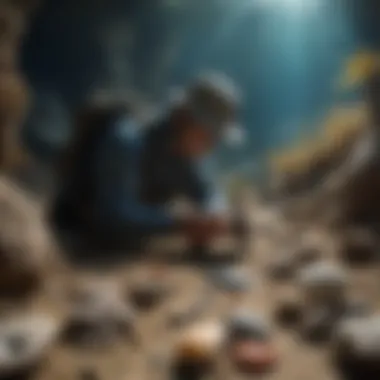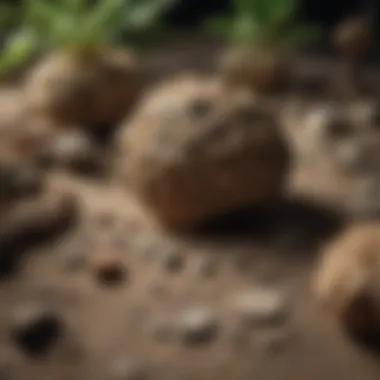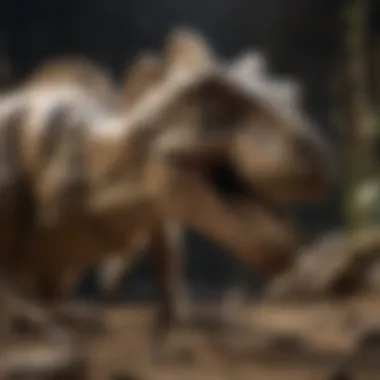Unveiling the Educational Advantages of Fossil Kits in Classroom Settings


Rock and Fossil Identification
In the realm of rock and fossil identification, it is crucial to understand the diverse array of rocks and fossils that one may encounter. From sedimentary to igneous rocks, each type possesses unique characteristics that set them apart. Fossils, on the other hand, offer insight into prehistoric worlds, with various types such as petrified wood, trilobites, and ammonites. When exploring these specimens, it is essential to pay attention to specific characteristics like texture, color, and structure, which can provide clues about their origins. Utilizing tools such as magnifying glasses, field guides, and rock hammers can facilitate the identification process, enabling enthusiasts to delve deeper into the world of paleontology.
Collecting Tips and Techniques
Embarking on a fossil-collecting journey requires adherence to best practices to ensure an enriching and ethical experience. Before setting out, it is important to research and identify prime collecting sites where fossils can be found in abundance. Tools such as chisels, brushes, and protective gear should be carried to safely extract specimens without causing damage. Upon locating fossils, gentle techniques should be employed to carefully extract them from the surrounding sediment to preserve their integrity. By following these tips and techniques, rock and fossil collectors can enhance their collections while contributing to the preservation of geological heritage.
Preservation and Display
Preserving and displaying collected rocks and fossils is an art form that requires attention to detail and precision. Techniques such as cleaning with soft brushes, air drying, and using archival-quality materials can aid in preserving specimens for future generations to admire. Proper storage methods involving acid-free paper, foam inserts, and sturdy containers safeguard the integrity of rocks and fossils while preventing decay. When it comes to displaying these treasures, creative ideas like shadow boxes, custom shelving, and themed exhibits can showcase the beauty and historical significance of each specimen, evoking curiosity and admiration among viewers.
Geological Insights
Delving into the geological insights offered by rocks and fossils unveils a rich tapestry of Earth's history and evolution. Examining geological formations and processes allows collectors to gain a deeper appreciation for the forces that have shaped our planet over millennia. Moreover, understanding the historical significance of certain rocks and fossils sheds light on past ecosystems, climate changes, and evolutionary milestones. Notable discoveries in the field of paleontology offer glimpses into ancient worlds, showcasing the remarkable diversity of life that once thrived on Earth. By exploring these geological insights, enthusiasts can embark on a journey through time, unraveling the mysteries held within Earth's rocky layers.
Introduction
In this article, we are delving deep into the educational value that fossil kits can bring to classroom settings. Fossil kits offer a unique hands-on learning experience that goes beyond traditional teaching methods. By incorporating fossil kits into the curriculum, educators have the opportunity to engage students in the fascinating realms of paleontology and geology, sparking curiosity and deepening their understanding of natural history and scientific inquiry. This exploration will shed light on the benefits, considerations, and significant impact these educational tools can have on students' learning.
Overview of Fossil Kits
What are Fossil Kits?
Fossil kits are educational tools that contain replica fossils, excavation tools, and instructional resources, designed to provide students with a hands-on experience in paleontology. These kits aim to simulate the process of fossil discovery and excavation, allowing students to immerse themselves in the world of fossils and ancient life forms. The hands-on nature of fossil kits enhances experiential learning by enabling students to actively participate in scientific exploration, fostering a deeper connection with the subject matter.
Types of Fossil Kits Available
There is a wide array of fossil kits available, ranging from basic sets for beginners to advanced kits for more experienced learners. These kits may focus on different aspects of paleontology, such as dinosaur fossils, plant fossils, or marine fossils, catering to various interests within the field. The diversity in fossil kits allows educators to select kits that align with their teaching objectives and students' learning levels, ensuring an enriching and tailored educational experience.
Benefits of Using Fossil Kits in Education


The utilization of fossil kits in education brings forth numerous benefits for students. Apart from fostering a hands-on approach to learning, these kits promote critical thinking skills, curiosity, and a deeper appreciation for scientific processes. By engaging with fossil kits, students develop observation skills, logical reasoning, and an understanding of the Earth's history, creating a dynamic learning environment that encourages exploration and inquiry.
Significance of Hands-On Learning
Importance of Experiential Learning in Science Education
Experiential learning plays a crucial role in science education as it allows students to translate theoretical knowledge into practical application. By engaging in hands-on activities like exploring fossil kits, students not only deepen their understanding of scientific concepts but also strengthen their problem-solving skills and critical thinking abilities. This active participation in learning cultivates a sense of ownership and enhances retention of information, making complex scientific principles more accessible and relatable.
Enhancing Student Engagement Through Hands-On Activities
Hands-on activities, such as those involving fossil kits, have the power to capture students' interest and sustain their engagement in the learning process. By employing interactive learning experiences, educators can create immersive environments that cater to diverse learning styles, promoting inclusivity and a sense of accomplishment among students. Through hands-on activities, students are encouraged to explore, question, and discover, resulting in a more profound and meaningful educational journey.
Remember, each element of the article should be meticulously crafted to provide comprehensive insights and detailed analysis, appealing to the intellect of rock and fossil collectors as the target audience. Strive for originality, depth, and clarity in your writing to captivate and educate readers effectively.
Educational Impact of Fossil Kits
When delving into the realm of paleontology and geology education, the significance of fossil kits cannot be overlooked. These hands-on learning tools play a crucial role in enhancing the educational experience for students by providing tangible experiences in a classroom setting. The educational impact of fossil kits extends beyond mere theoretical knowledge, allowing students to immerse themselves in the intricate world of fossils and geological processes. By closely examining the benefits and considerations of integrating fossil kits, educators open up a gateway to a deeper understanding and appreciation for natural history and scientific inquiry.
Promoting Scientific Inquiry
Encouraging Critical Thinking Skills
Encouraging critical thinking skills through the use of fossil kits is paramount in nurturing analytical minds among students. By engaging in hands-on activities that require observation, analysis, and interpretation, students develop essential cognitive abilities that are transferrable across various subject areas. The inherent nature of examining fossils and geological specimens prompts students to ask questions, evaluate evidence, and form hypotheses, fostering a culture of scientific inquiry and discovery. The process of critical thinking encouraged by fossil kits paves the way for students to become independent learners equipped with the tools to navigate complex scientific concepts effectively.
Fostering Curiosity and Exploration
Fossil kits act as catalysts for fostering curiosity and promoting a spirit of exploration in students' learning journeys. By immersing students in the world of paleontology and geology through interactive experiences, fossil kits ignite a passion for discovery and investigation. The hands-on exploration of fossils not only instills a sense of wonder but also encourages students to delve deeper into the rich history encapsulated within each specimen. Fostering curiosity through fossil kits cultivates a sense of lifelong learning and an innate drive for exploration, laying a strong foundation for continuous intellectual growth and scientific curiosity.
Developing Observation Skills
Understanding Geological Processes


The aspect of understanding geological processes using fossil kits offers students a unique opportunity to grasp the dynamic forces that have shaped Earth's history. By examining fossils and sedimentary layers, students gain insights into the intricate processes of fossilization, sedimentation, and fossil preservation. This hands-on experience enhances students' observational skills as they decipher the clues embedded in geological formations, enabling them to unravel the complex tapestry of Earth's geological history. Understanding geological processes through fossil kits nurtures a deeper appreciation for the dynamic nature of our planet and the geological forces that continue to shape its landscapes.
Identifying Fossil Specimens
Identifying fossil specimens using fossil kits serves as a practical exercise in honing students' observational and classification skills. By examining various fossils and distinguishing their unique characteristics, students develop the ability to identify different species, categorize specimens, and draw inferences about past environments. The act of identifying fossil specimens not only sharpens students' observational acumen but also instills a sense of scientific rigor and attention to detail. This hands-on skill of fossil identification equips students with the tools to analyze and interpret fossil evidence, fostering a deeper understanding of the organisms that inhabited our planet in ancient times.
Integration in Classroom Curriculum
In the realm of education, the integration of fossil kits into the classroom curriculum serves as a pivotal element in enhancing students' experiential learning. By infusing hands-on paleontology and geology activities into various subjects, educators can break down traditional silos and offer a multidisciplinary approach to learning. This integration not only fosters a deeper understanding of scientific concepts but also promotes critical thinking, problem-solving, and creativity among students.
Emphasizing the relevance of integration in classroom curriculum within this article sheds light on the transformative impact of incorporating practical learning tools like fossil kits. Educators are provided with a unique opportunity to bridge theoretical knowledge with real-world applications, creating a dynamic learning environment that caters to diverse learning styles and strengths. The seamless integration of fossil kits across subjects paves the way for a holistic educational experience, where students can connect various disciplines and deepen their knowledge through hands-on exploration.
Incorporating Fossil Kits Across Subjects
Interdisciplinary Connections
Delving into the realm of interdisciplinary connections within the educational landscape reveals a key aspect of incorporating fossil kits across subjects. By integrating paleontological and geological themes into multiple disciplines such as history, geography, and biology, educators can offer students a comprehensive understanding of the interconnected nature of scientific fields. This interdisciplinary approach not only enriches the learning experience but also fosters a well-rounded perspective on natural history and evolution.
The unique characteristic of interdisciplinary connections lies in its ability to transcend traditional subject boundaries and encourage students to think holistically about complex scientific concepts. By weaving together various disciplines through the common thread of fossil kits, educators can spark curiosity and instill a sense of interconnectedness among students, promoting a deeper appreciation for the interdisciplinary nature of scientific inquiry.
Cross-Curricular Applications
Unpacking the significance of cross-curricular applications in the context of fossil kits integration unveils a multipurpose educational strategy that enhances the overall learning experience. By incorporating fossil kits across different subjects, educators can create a cohesive learning journey that reinforces key concepts through repetition and application. This approach not only reinforces cross-cutting themes but also strengthens students' knowledge retention and transferability.
The key characteristic of cross-curricular applications lies in its ability to offer students a multi-faceted learning experience that transcends individual subject boundaries. By engaging with fossil kits in various subject areas, students can develop a holistic understanding of paleontology and geology while honing their analytical, critical thinking, and problem-solving skills. The diverse advantages of cross-curricular applications in this article underscore its effectiveness in promoting interdisciplinary learning and interconnectivity among different fields.
Adapting to Different Learning Styles
Catering to Visual and Tactile Learners
Addressing the needs of visual and tactile learners through the integration of fossil kits caters to a diverse range of learning styles and preferences. By incorporating visual aids, replicas, and hands-on activities, educators can effectively engage visual and tactile learners in the exploration of paleontological and geological concepts. This hands-on approach not only enhances understanding but also encourages active participation and knowledge retention among students.


The key characteristic of catering to visual and tactile learners lies in its focus on experiential learning and sensory engagement, allowing students to interact with scientific concepts in a tangible and memorable way. Through the use of fossil kits, educators can create immersive learning experiences that resonate with visual and tactile learners, fostering a deep appreciation for natural history and scientific inquiry.
Promoting Inclusivity in Science Education
Examining the role of promoting inclusivity in science education through the utilization of fossil kits highlights a commitment to creating a welcoming and accessible learning environment for all students. By embracing diverse learning styles, abilities, and backgrounds, educators can ensure that every student has the opportunity to engage meaningfully with paleontology and geology. This inclusive approach not only fosters a sense of belonging but also promotes equity and diversity in science education.
The unique feature of promoting inclusivity in science education lies in its emphasis on personalized learning and individualized support for students with varying needs. By tailoring educational experiences to accommodate diverse learning styles, educators can cultivate a culture of inclusivity that celebrates the unique strengths and perspectives of each student. The inherent advantages of promoting inclusivity in this article underscore its significance in creating a supportive and enriching learning environment for all learners.
Practical Considerations for Educators
In the realm of educational resources, the topic of practical considerations for educators stands as a crucial pillar in ensuring a successful learning environment when integrating fossil kits in classroom settings. Educators bear the responsibility of selecting appropriate fossil kits that align with educational standards while providing engaging and enriching experiences for their students. By carefully evaluating the quality and relevance of fossil kits, educators can tailor their teaching methods to foster a deeper understanding and appreciation for paleontology and geology among learners. The significance of practical considerations for educators lies in the pivotal role they play in shaping students' educational journeys and in sparking a lifelong interest in scientific exploration.
Sourcing Quality Fossil Kits
When it comes to sourcing quality fossil kits, educators are faced with the task of selecting kits that not only meet academic standards but also captivate students' interest and curiosity. The criteria for selecting educational fossil kits are multifaceted and encompass aspects such as accuracy, educational value, and durability. Educators should prioritize kits that offer authentic specimens, detailed educational materials, and hands-on activities that promote active learning. By opting for kits that meet these criteria, educators can ensure that students engage meaningfully with the subject matter, leading to a more profound educational experience.
Ensuring Authenticity and Educational Value
Authenticity and educational value are two cornerstones that educators should prioritize when choosing fossil kits for classroom use. Ensuring that the specimens included in the kits are genuine and accurately represented enables students to connect with the material on a deeper level, promoting a sense of authenticity in their learning. Additionally, educators must assess the educational value of the kits by considering the depth of information provided, the clarity of instructions, and the alignment with curriculum standards. By selecting kits that prioritize authenticity and educational value, educators can instill a sense of trust and reliability in their teaching materials, enhancing the overall educational experience for students.
Implementation Best Practices
Incorporating fossil kits into lesson plans requires a strategic approach that integrates hands-on learning experiences seamlessly into the curriculum. By weaving fossil kits into lesson plans, educators can create interdisciplinary connections that enhance students' understanding of various subjects while reinforcing key concepts in paleontology and geology. The integration of fossil kits into lesson plans not only adds a practical dimension to learning but also cultivates critical thinking skills and scientific inquiry among students. Furthermore, facilitating hands-on learning experiences through fossil kits allows students to explore scientific concepts in a tangible and engaging manner, fostering a deeper appreciation for the natural world and the wonders of geology.
Facilitating Hands-On Learning Experiences
Facilitating hands-on learning experiences through fossil kits offers students the opportunity to actively engage with scientific content and develop essential skills such as observation, analysis, and problem-solving. By providing hands-on experiences, educators can cater to diverse learning styles and create inclusive learning environments where all students can participate and thrive. Hands-on learning experiences not only enrich students' educational journeys but also nurture a sense of curiosity and wonder, sparking a passion for lifelong learning and scientific discovery. Through the facilitation of hands-on learning experiences, educators can empower students to explore the world of paleontology and geology with enthusiasm and confidence, setting the stage for a future generation of informed and curious learners.
Conclusion
By reflecting on the content presented throughout this article, it becomes evident that fossil kits play a crucial role in enhancing student engagement and promoting scientific inquiry. The hands-on nature of fossil kits fosters critical thinking skills and encourages curiosity and exploration, emphasizing the importance of experiential learning in science education.
Moreover, the development of observation skills through fossil kits enables students to gain a comprehensive understanding of geological processes and enhances their ability to identify fossil specimens. This practical learning approach not only complements traditional classroom teachings but also provides a tangible link to the natural world, fostering a deeper appreciation for natural history.
Through the integration of fossil kits into classroom curriculum, educators can cater to different learning styles, promote interdisciplinary connections, and create inclusive learning environments. By adopting best practices in sourcing quality fossil kits and implementing them effectively in lesson plans, educators can empower students to engage in hands-on learning experiences that enrich their educational journey.
Overall, the educational potential of fossil kits in classroom settings is vast, offering a unique opportunity to inspire lifelong learning and scientific inquiry among students. By leveraging the intrinsic value of hands-on paleontology and geology activities, educators can ignite a passion for natural history and nurture a curiosity for exploring the wonders of the past.







